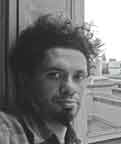« Features
Kettle’s Whistle: The Phantom of the Community
The local community - that unpredictable, unquantifiable, factor whose feedback has dominated the activity of every museum or contemporary art institution ever since their policy of decentralization started taking place in the early 1990s. There is always something slightly manipulating in the idea of educating the public to interact with the presence of these cathedrals in the desert; yet episodes like Frank Gehry’s Guggenheim Museum in Bilbao or, more recently, the Folkestone Triennial in southern England, suggest that an almost Darwinian sense of adaptability develops in response to these intrusions, especially when possibilities of solid economic development are involved.
Folkestone is a coastal town who used to be one of Londoner’s favorite touristic destinations before boarding a plane to Spain became cheaper than taking a train to the south of England. The long line of abandoned hotels and empty beach resorts didn’t take away any of its original charm, but no doubt, it now qualifies as a depressed area if compared to its golden age. When the first Folkestone Triennial opened in 2008 the local reception was lukewarm, tinted with suspicions if not outright hostility. The Folkestone Art Society defiantly announced its total estrangement; regular users of the promenade benches vocally complained about the annoying voices reading wartime letters coming from Christian Boltanski’s installation; the general feeling was possibly summarized at its best when the guided tour organized by curator Andrea Schlieker hit Heather and Ivan Morison’s travelling library. As soon as question time came, following a detailed explanation of the public benefits of the artists’ social intervention, an elder lady who had quietly followed the professional crowd from a distance raised her hand and asked who was paying for it.
This year’s edition, in contrast, was characterized by a whole different mood. Parallel exhibitions of students and local painters popped up in every corner of the town; Cornelia Parker’s bronze mermaid facing the sea was universally appreciated; and works from the previous editions that enjoyed permanent status, like Patrick Tuttofuoco’s harbor sculpture or Tracey Emin’s casts of baby shoes and clothes, which have survived the three intervening years vandalism-free. Folkestone might be still a long way from turning into a new Kassel or Münster, but its experiment in giving a once popular destination a taste of its glorious past is proving to be successful.
When it comes to a place like London, however, it is surprising to see how a logic that rules semi-desolated posts can be applied to a city with a reputation for being one of the multicultural bastions in the western world. Partly due to its topographic nature, which consists of a series of small centers all patched together, and partly because of the lack of a real art nucleus like New York’s Chelsea or Paris’ Marais. With galleries dispersed over a metropolitan area of 607 square miles, London is still the kind of place where every art event that dares to venture beyond the safety zone delimited by Kensington, Fitzrovia, Barbican and Southbank bears scrutiny when it ignores the locals; never mind if a survey, like the sculpture exhibition “Bold Tendencies,” now in its fifth edition, manages to gather over 2,000 people on the rooftop of a parking lot in Peckham on its opening night in June.
The meeting between international and local contingents has taken a dramatic twist last May when Christoph Büchel inaugurated his solo exhibition at Hauser & Wirth. Rather than bringing art to the masses, Büchel did things the other way around, inaugurating for two months the ‘Piccadilly Community Centre’, establishing a local community in a place where there hadn’t been one in a long time. The identity of the gallery was completely erased, with the aseptic exhibiting spaces leaving room to Internet hot spots, Western Union desks, skanky bar rooms, charity shops and nurseries. It’s not the first time that Büchel pushes those boundaries, but ‘Piccadilly Community Centre’ is not just about architectural reinvention. It pushes the concept to a new level, opening the space of a blue chip gallery to yoga classes, tea dances, and gathering sessions in an environment so close to the real thing that many visitors had a hard time figuring out what was going on. In line with Büchel’s previous works, a few Easter eggs were strategically placed along the way, with small doors and ladders leading to a maze of cavernous rooms, featuring improvised beds next to stacks of porno magazines, rotten fiberglass and dusty music tapes. ‘Total’ installations of these kinds are generally accused of being excessively convivial and too distant from the viewer/object equation that sets the standard of every art exhibition, but ‘Piccadilly Community Centre’ is far from being something for everybody. Its radicalness is not just structural; it is extended to the experience itself, which has to follow a very specific pattern regardless of the apparently limitless options. How ‘Piccadilly Community Centre’ marks a new chapter in the relationship between art and local community members, is a subject to debate, but it was fun for once to see the formers, as opposed to the latters, wondering around at loss, with the question ‘is this art?’ hovering over their head.




































